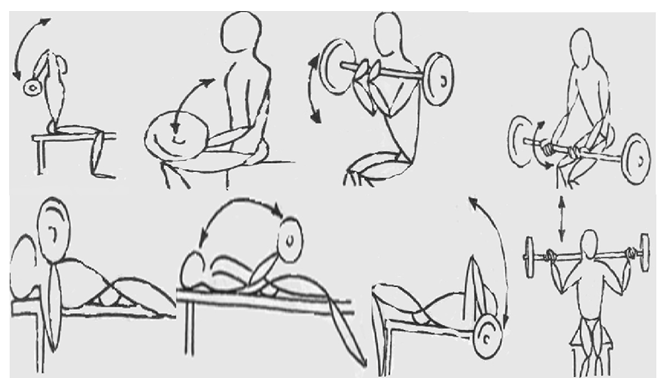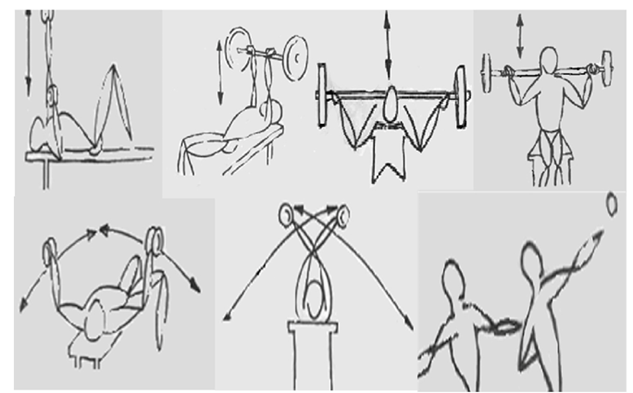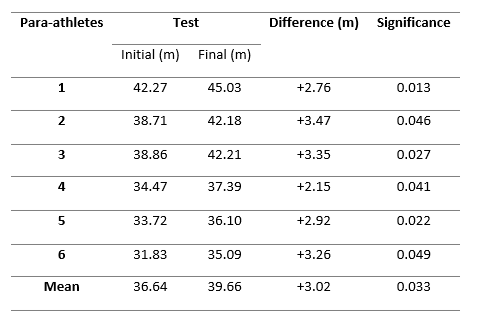Mi SciELO
Servicios Personalizados
Articulo
Indicadores
-
 Citado por SciELO
Citado por SciELO
Links relacionados
-
 Similares en
SciELO
Similares en
SciELO
Compartir
Ciencia y Deporte
versión On-line ISSN 2223-1773
Ciencia y Deporte vol.8 no.3 Camagüey sept.-dic. 2023 Epub 04-Sep-2023
http://dx.doi.org/10.34982/2223.1773.2023.v8.no3.004
Original article
Enhancing Quick Strength Effectiveness in Discus-Throwing Para-Athletes, F-56
1Universidad de Granma. Facultad de Cultura Física. Granma, Cuba.
Introduction:
Physical Culture professionals offer significant contributions to high-performance sports by implementing didactic and other associated sciences. ence, this research focused on the results of enhancing quick strength effectiveness in discus-throwing para-athletes (F-56).
Aim:
To assess the effectiveness of a set of general and particular exercises to enhance quick strength in para-athletes in the area of discus throwing (F-56 category), who suffer from spinal cord injury, to raise their sports results.
Methods:
In that sense, several theoretical, empirical, and statistical-mathematical methods were used. The study was done between 2020 and 2021, using a sample consisting of six male para-athletes (the total population representing this event), who met the technical requirements for the sport but had insufficient muscular strength.
Results:
The set of exercises suggested to increase the muscular strength of para-athletes in the study, as part of their physical training, led to an increase in strength levels, based on a methodological rationale for satisfactory planning of the different types of preparation, which included the proper methods, contents, and means.
Conclusions:
The general and special physical preparation exercises for the strengthening of the motor disabled athletes in the research were based on a methodological basis that allowed the trainer to plan the work of the different types of preparation correctly, with the methods, contents and means for their development.
Key words: Discus throwing; para-athletes; physical-motor disability; spinal cord injury; muscular strength.
INTRODUCTION
In Cuba, Villa Nueva, H. et al. (2020), Ramos, Miló, and González (2020), have studied basic exercises in detail with a view of enhancing strength as a starting point as well as the basis for technical teaching in sports training. Likewise, they have stressed physical preparedness, particularly the conditional capacity of strength. Meanwhile, Mojena, Fonseca, García-Camejo & Hernández-Barcaz (2022), have engaged in leg strength training from early ages. In terms of quick strength, Remón-Futiel, Ortega-Liens, García-Camejo & Peña-Fernández (2022), focused on baseball athletes. Volkov (1968) and Ozolin (1971), cited by Mendoza-Romero, Méndez-Infante & Peña-Santiesteban (2016) noted that improvements in quality speed-strength (quick strength) rely on the development of the potentialities of the body to deploy the alactacid anaerobic energy mechanism (p.128). According to these authors, quick strength takes place as the predominant physical quality in short and explosive efforts.
They embrace the theory stated by Siff & Verkhoshansky (2004), who said that "... if strength deficit is substantial for a certain muscle group, there could be an increase in quick strength caused by maximum neuromuscular stimulation or near this zone (for instance, using weightlifting or plyometrics). If the strength deficit is little, on the other hand, hypertrophy may be induced by sub-maximum load methods, such as the ones frequently used in bodybuilding, followed by extreme efforts with huge loads (p.27).
Egea García and Sarabia Sánchez (2002) stated that, since 1980, the World Health Organization (WHO) used the term disability to refer to "every restriction or absence of the capacity to perform an activity in the way or within the human standards." (p. 2). Despite the bias, its application is increasingly being accepted and used.
Barreiro, Guerra Martínez & Rodríguez Elías (2020), citing Reina (2010) and Pérez (2012), have stated that
Adapted sport is understood as a form of sport that adjust to the group of people with a disability or a special health condition, either due to a series of adaptations and/or modifications to enable their practice by the disabled, or because the structure of the sport favors its practice (p.110).
Athletics, an Olympic and Paralympic sport, is one of the emblematic sports disciplines for people with certain limitations or disabilities, to be able to perform physical activities, and the one with the largest number of participants and events. In the Paralympics, the sport is named Para-Athletics, which among many disciplines, includes discus throwing.
Ferrer & González Nobal, (2022), refer that
To succeed in discus throwing, athletes with a disability in a wheelchair need the best techniques, coordination, concentration, movement speed, and muscular strength to be effective in the competition (p.49).
As to enhancing discus throwing techniques, Romero, Valverde Irúa & Morales Pillajo (2019) referred to the conventional juvenile categories.
On Para-athletics, Rojas Moreno (2021) explained that there are two ways in which the athletes may start a competition, depending on their disability: from a wheelchair inside a specific area (generally those who have or use a wheelchair), and for those who can use their legs as support. While the object has the same weight as the one used by conventional athletes, 2 kg for men, and 1 kg for women (par. 5). This research study targets para-athletes in wheelchairs.
The implementation of general and specific exercises to develop quick strength as a manifestation of muscular strength, based on research done by Ferrer & González Nobal (2022) is a precedent of this study, as both are part of the same project, whose specific objectives are to contribute to the systematic increase of competitive outcomes; encourage the setting of better marks, physical and spiritual conditions in the athletes that favor their personality as a whole; increase overall and multipurpose physical development; ensure and improve specific physical development depending on the needs for competition; increase the general and special level of preparedness.
Accordingly, para-athletes should be able to:
Perform general and special physical exercises correctly, as a way of conditioning strength in the throwers, according to their specificities. Demonstrate physical preparedness that allows them to reach higher results in measured tests that evaluate physical preparedness at the end of the annual training macrocycle (Ferrer & González Nobal, 2022, p.54).
Therefore, the aim of this study is to assess the effectiveness of a set of general and particular exercises to enhance quick strength in para-athletes in the area of discus throwing (F-56 category), who suffer from spinal cord injury, to raise their sports results.
MATERIALS AND METHODS
The study relied on a pre-experimental design with minimum control. Initial and final tests (pre-test and post-test) were made with an independent variable, the application of the general and special exercises, then it was evaluated in the final confirmation, and its effectiveness was checked. This research was done in the province of Granma, Cuba, in the 2020-2021 period, following the Paralympics Tokyo 2020, which was held in 2021.
The sample consisted of intentional, non-probabilistic sampling. The population was the discus-throwing para-athletes (F-56) belonging to the Cuban pre-selection. All six athletes were selected for the experiment (100%), with an average age of 32.3 years. The following inclusion criteria were taken into consideration: discus throwing para-athletes (F-56), certified by the International Paralympic Committee (IPC) and the National Commission of Athletics to be part of the national pre-selection
The investigation relied on theoretical, empirical, and research techniques, such as analytical-synthetic, inductive-deductive, systemic-structural functional, documentary analysis, methodological and source triangulation, structured observation, interview, and survey. Discus-throwing training was observed (planning and execution with weights, muscular development, increase of maximum muscular strength, methods and means used by the coaches to achieve their goal associated with quick strength).
A questionnaire was made for coaches about muscular strength training. Several regulatory documents were reviewed in relation to training disabled athletes, and the comprehensive program for athlete preparedness in the area of throwing (PIPD) for conventional athletes was analyzed as well. The para-athletes were interviewed about their needs in terms of quick strength.
The evaluation of quick strength followed the existing methodology. Lying on the floor and sitting were the two strength indicators (frontal) measured to assess the effectiveness of the general and special exercises.
RESULTS AND DISCUSSION
The information collected through observations of training sessions, interviews of para-athletes, a questionnaire to coaches about quick strength training, and the review of several documents, including papers and thesis dissertations was used to diagnose the muscular strength training in discus throw para-athletes (F-56). It facilitated the methodological and source triangulation.
The triangulation showed various deficiencies in weight training planning, which did not take into account the zones of intense work.
There were problems with the speed of exercise with weights.
Poor muscular development, below the expectations, in one part of the sample.
Poor maximum muscular strength increases following the controls.
Shortcomings in the implementation of methods and means to enhance quick strength.
Theoretical and methodological issues related to quick strength training in discus throwing para-athletes (F-56).
Adjustment of quick strength training of conventional sports to para-athletics.
Poor definition of the objectives targetting quick strength at different training stages in the next year's macrocycle.
Deficiencies in planning concrete loads to enhance quick strength with a sports gesture perspective.
Few guiding documents about the sports training of discus throw para-athletes (F-56), especially quick strength.
The previous aspects evidence the need to implement general and special exercises to train quick strength in discus-throwing para-athletes (F-56).
A proposal for general and special physical exercises
General objective: to implement general and special physical exercises to strengthen different muscular planes of discus-throwing para-athletes with spinal cord injuries, in the F-56 category (Figure 1 and Figure 2) and (Table 1). (Ferrer & González Nobal, 2022)
Table 1. -Dosage of general and special exercises
| Category | EPFG | EPFE | EPC | Methods |
| F-56 | 3/8 repetitions. Frequency 3/Weekly | 2/3; 2/3; 2/2 Frequency 3/Weekly Stressing specific discus throw exercises | Triceps Biceps Strength while lying down Strength while sitting (frontal) | Repetitions Standard Continuous standard repetition Interval standard |
Assessment of the effectiveness of general and special exercises for the development of rapid strength in para-athletes through pre-experiment
To assess the effectiveness of general and specific exercises using this methodology to enhance quick strength in discus-throwing para-athletes, all the population in the study was included in the 2020-2021 training macrocycle, which consisted of staged exercises, based on the application of basic, special, and competitive exercises, according to the physical loads planned. It required the combination of all the components of training (physical, technical, tactical, psychological, and theoretical), partially modeling and integrating the specific competition event, with practical elements.
Results of the implementation of the set of exercises
At the end of each stage and mesocycle, training was checked and the utilization of the loads planned was assessed, which permitted the control and evaluation of the exercise set implementation at different moments. Accordingly, two strength tests were performed: lying, and sitting, with a more general view.
Analysis of the test results
The significant differences in variable maximum strength in the upper limbs, between the pre-test and post-test were established with the statistical analysis, using the Student-T test for the comparison of the arithmetic means of the samples related. To determine if the data fit the normal curve, pd" 0.05 in the Student-T test, which during the analysis of the quick strength of para-athletes in the pre-test and post-test, showed that because P had the lowest value of the tests (greater than or equal to 0.05), the quick strength data from the two tests may have had a normal distribution with 95 % confidence.
Results of the strength test while sitting
Table 2 shows the statistical results of the pre-test and post-test about strength from a sitting position. There was an increase in the mean values of maximum strength, from the beginning of the preparation until the end of the competitive stage (Table 2).
Results of the strength test while lying down
The analysis was started using the results in Table 2, which show a progressive increase in the mean values of maximum strength, from the beginning of the preparation until the end of the competitive stage.
Overall, the sitting and lying down tests showed low variation coefficients, thus indicating the homogeneity of the control steps, while the statistical values showed significant differences in the tests.
The analysis of the control (pre-test and post-test) shows an increase in the throws (Table 3), evidencing a significant difference.
In general terms, the pre-test and post-test paired sample analysis (SPSS, 22.0) tackled the differences between the data samples. The results of the study suggest that the experimental hypothesis can be accepted; the previous results express a significant difference (p ≤ 0.05), among the quick strength enhancing indicators in discus-throwing para-athletes between the pre-test and the post-test, with improvements observed in the post-test.
Table 2. - Pre-test and post-test comparison
| Indicators | Pre-test(kg) | Post-test(kg) | Difference(kg) | Significance |
|---|---|---|---|---|
| Maximum strength | Maximum strength | Maximum strength | ||
| Strength while sitting | 67.9 | 78.6 | +10.7 | 0.000 |
| Strength while lying down | 127.2 | 138.6 | +11.4 | 0.000 |
Between August 24th and September 5th, 2021 Tokyo hosted the 2020 Paralympics, in which discus thrower Leonardo Diaz (part of this study) participated in good physical and psychological conditions, ready to fight for an outstanding position. His goal was achieved when he won the bronze medal (43.36 m), despite his disagreement with the mark recorded officially.
CONCLUSIONS
The coaches or technicians in charge of disabled athlete training with spinal cord injury (F-56) in discus throwing do not follow a standard document with the implicit type of exercises for their general and special physical training aiming to enhance their strength, deal with the training process coherently, and meet their particular needs.
The exercises for the general and special physical preparedness to increase the muscular strength of motor-disabled athletes in the study were based on a methodological rationale for satisfactory planning of the different types of preparation, which included the proper methods, contents, and means.
The level of general athlete satisfaction was palpable since they consider themselves useful people who can contribute to the social growth of their communities.
REFERENCIAS BIBLIOGRÁFICAS
Barreiro, R. A., Guerra Martínez, N., & Rodríguez Elías, A. O. (2020). Diagnóstico de la velocidad de movimiento en el lanzamiento del disco en atletas con discapacidad físico motora. Revista Olimpia, 17. https://revistas.udg.co.cu/index.php/olimpia/article/download/1945/3630/ [ Links ]
Egea García, C., y Sarabia Sánchez, A. (2002). Clasificaciones de la OMS sobre discapacidad. Murcia. España. https://sid-inico.usal.es/idocs/F8/ART6594/clasificacion_oms.pdf [ Links ]
Ferrer, Y., & González Nobal, A. S. (2022). Ejercicios físicos generales y especiales para el fortalecimiento muscular de los atletas discapacitados en la categoría F-56 (Lesionados medulares) en el lanzamiento del disco. Revista Olimpia, 19(2), abril-junio. https://xjournals.com/collections/articles/Article?qt=jh /gGJCQfwN3CKyuRaLXvcCvXktBGDMaz02OCLRzqpc= [ Links ]
Mojena, V., Fonseca, I. J., García-Camejo, G., & Hernández-Barcaz, M. (2022). El entrenamiento de la fuerza de piernas en edades tempranas y su rendimiento deportivo en el polo acuático. Ciencia y Educación, 3(4) (abril). https://www.cienciayeducacion.com/index.php/journal/article/view/127 [ Links ]
Ramos, M., Miló, M., y González, S. C. (2020). Diagnóstico para perfeccionar la fuerza especial en agua de polo acuático en Pinar del Río. PODIUM. Revista de Ciencia y Tecnología en la Cultura Física, 15(2) (mayo-agosto). http://scielo.sld.cu/pdf/rpp/v15n2/1996-2452-rpp-15-02-250.pdf [ Links ]
Remón-Futiel, G. A., Ortega-Liens, A. G., García-Camejo, G., & Peña-Fernández, J. M. (2022). El entrenamiento de la fuerza rápida en atletas de béisbol categoría sub23 años. Ciencia y Educación, 3(4) (abril). https://www.cienciayeducacion.com/index.php/journal/article/view/128 [ Links ]
Rojas, J. (2021). ¿Qué es el lanzamiento del disco paralímpico? Señal Colombia. https://www.senalcolombia.tv/deportes/que-es-lanzamiento-disco-paralimpico [ Links ]
Romero, E., Valverde Irúa, C., & Morales Pillajo, C. (2019). Perfeccionamiento del desempeño técnico en la fase de descarga del lanzador de disco prejuvenil. Revista Cubana de Investigaciones Biomédicas, 38(2), pp.15-26. http://scielo.sld.cu/pdf/ibi/v38n2/1561-3011-ibi-38-02-15.pdf [ Links ]
Siff, M. C., & Verkhoshansky, Y. (2004). Superentrenamiento. 2da ed. España: Editorial Paidotribo, Coleccion Deporte & Entrenamiento. https://books.google.com.cu/books/about/SUPERENTRENAMIENTO.html?hl=es&id=-CQPml3N-24C&redir_esc=y [ Links ]
Villa Nueva, H. et al. (2020). Programa integral de preparación del deportista para el área lanzamiento. La Habana: Federación Cubana Atletismo (documento en PDF). [ Links ]
Received: April 01, 2023; Accepted: May 20, 2023











 texto en
texto en 





